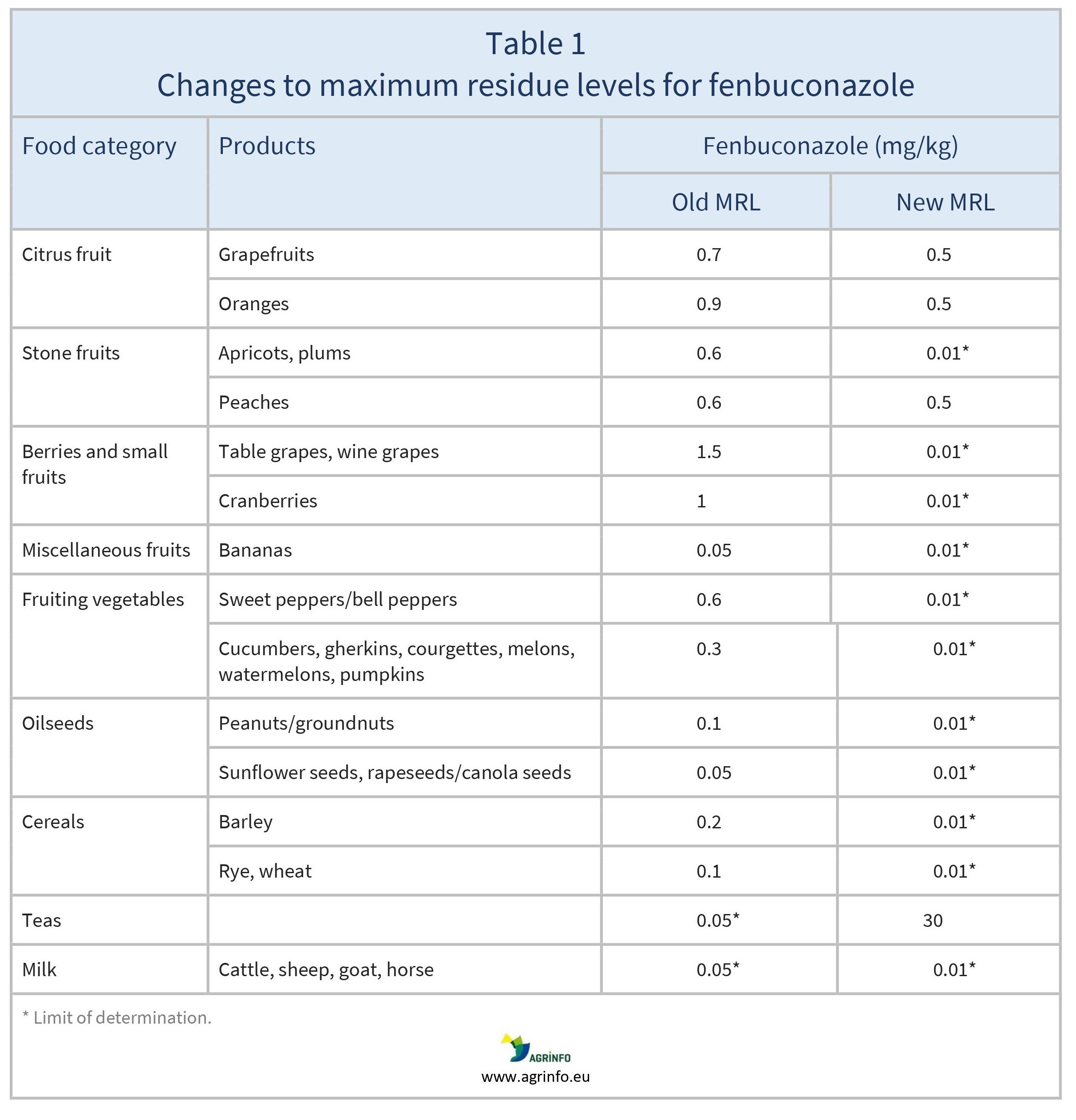Maximum residue levels for fenbuconazole
- Pesticide MRLs
Summary
The European Union has amended the maximum residue levels (MRLs) for fenbuconazole. The most significant impacts will be on exports of apricots, plums, grapes, cranberries, bananas, sweet/bell peppers, cucurbits, sunflower seeds, peanuts, rapeseeds, barley, rye, and wheat.
EU aligns fenbuconazole MRLs on certain products with Codex Standards
Commission Regulation (EU) 2025/195 of 3 February 2025 amending Annex II to Regulation (EC) No 396/2005 of the European Parliament and of the Council as regards maximum residue levels for fenbuconazole and penconazole in or on certain products
Update
The European Union has amended the maximum residue levels (MRLs) for fenbuconazole. The most significant impacts will be on exports of apricots, plums, grapes, cranberries, bananas, sweet/bell peppers, cucurbits, sunflower seeds, peanuts, rapeseeds, barley, rye, and wheat.
Impacted Products
Grapefruits, oranges, apricots, plums, peaches, table grapes, wine grapes, cranberries, bananas, sweet peppers/ bell peppers, cucumbers, gherkins, courgettes, melons, watermelons, pumpkins, peanuts/ groundnuts, sunflower seeds, rapeseeds/ canola seeds, barley, rye, wheat, tea, milk (cattle, sheep, goat, horse)
What is changing?
The EU has amended the MRLs for fenbuconazole as summarised in Table 1.
Why?
The MRLs for fenbuconazole were re-evaluated and adjusted after new trials addressed the data gaps identified by EFSA (2018). For grapefruits, oranges, and peaches, EFSA (2023) recommended lowering the MRLs to align with Codex MRLs (CXLs), while the MRLs on lemons, limes, mandarins, pome fruits, cherries, and blueberries could be maintained. Due to unaddressed data gaps, the MRLs will be lowered to the limit of determination (LOD) on apricots, plums, grapes, bananas, cranberries, sweet/bell peppers, cucurbits, and various seeds and cereals. (The LOD is the lowest level that can be detected using the most modern and reliable analytical methods.)
In addition, advances in analytical techniques allow lower LODs to be achieved for milk, so the LOD for milk will be lowered from 0.05 to 0.01 mg/kg.
The MRL on teas is increased following the adoption of a new CXL, for which EFSA (2022) concluded that there was no risk for consumers.
Timeline
The new MRLs apply from 24 August 2025.
Products exported before 24 August 2025 that comply with the old MRLs will not be removed from the EU market after that date, even if they do not comply with the new MRLs.
Recommended Actions
Suppliers of grapefruits, oranges, and peaches should review their use of fenbuconazole and assess whether any changes will be needed to existing good agricultural practices (GAP).
Exporters of apricots, plums, grapes, cranberries, bananas, sweet/ bell peppers, cucurbits, sunflower seeds, peanuts, rapeseeds, barley, rye, and wheat should look for possible alternative solutions in anticipation of the MRL changes.
Background
MRLs are set in accordance with the rules set out in Regulation 396/2005. For information on current MRLs for other substances, please consult the EU Pesticide Residues database.
Resources
EFSA (2018) Review of the existing maximum residue levels for fenbuconazole according to Article 12 of Regulation (EC) No 396/2005. EFSA Journal, 16(8): 5399.
EFSA (2022) Scientific support for preparing an EU position in the 53rd session of the codex committee on pesticide residues (CCPR). EFSA Journal, 20(9): 7521.
EFSA (2023) Evaluation of confirmatory data following the Article 12 MRL review for fenbuconazole. EFSA Journal, 21(8): 8205.
Sources
Commission Regulation (EU) 2025/195 as regards maximum residue levels for fenbuconazole and penconazole in or on certain products
Tables & Figures

Source: Regulation 2025/195
Disclaimer: Under no circumstances shall COLEAD be liable for any loss, damage, liability or expense incurred or suffered that is claimed to have resulted from the use of information available on this website or any link to external sites. The use of the website is at the user’s sole risk and responsibility. This information platform was created and maintained with the financial support of the European Union. Its contents do not, however, reflect the views of the European Union.
EU aligns fenbuconazole MRLs on certain products with Codex Standards
Commission Regulation (EU) 2025/195 as regards maximum residue levels for fenbuconazole and penconazole in or on certain products
What is changing and why?
The European Union has amended the maximum residue levels (MRLs) for febuconazole as summarised in Table 1. The European Food Safety Authority concluded that the MRLs for this substance on grapefruits, oranges, and peaches should be lower and aligned with Codex MRLs (CXLs). The MRL on teas is increased because a new CXL is considered safe for consumers. MRLs on lemons, limes, mandarins, pome fruits, cherries, and blueberries are maintained. Due to unaddressed data gaps, MRLs on apricots, plums, grapes, bananas, cranberries, sweet/bell peppers, cucurbits, and various seeds and cereals are lowered to the limit of determination (LOD, the lowest level that can be detected using the most modern and reliable analytical methods).
In addition, advances in analytical techniques allow the LODs in milk to be lowered to 0.01 mg/kg.
Actions
Suppliers of grapefruits, oranges, and peaches should review their use of fenbuconazole and assess whether any changes will be needed to existing good agricultural practices (GAP).
Exporters of apricots, plums, grapes, cranberries, bananas, sweet/ bell peppers, cucurbits, sunflower seeds, peanuts, rapeseeds, barley, rye, and wheat should look for alternative solutions in anticipation of MRL changes.
Timeline
The new MRLs apply from 24 August 2025.
Products exported before 24 August 2025 that comply with the old MRLs will not be removed from the EU market after that date, even if they do not comply with the new MRLs.
Tables & Figures

Source: Regulation 2025/195
Disclaimer: Under no circumstances shall COLEAD be liable for any loss, damage, liability or expense incurred or suffered that is claimed to have resulted from the use of information available on this website or any link to external sites. The use of the website is at the user’s sole risk and responsibility. This information platform was created and maintained with the financial support of the European Union. Its contents do not, however, reflect the views of the European Union.
